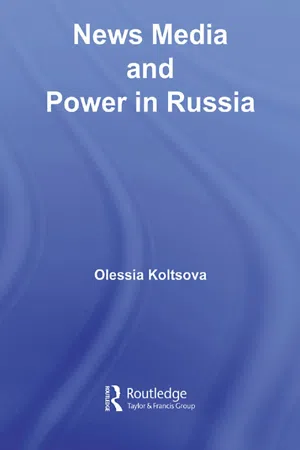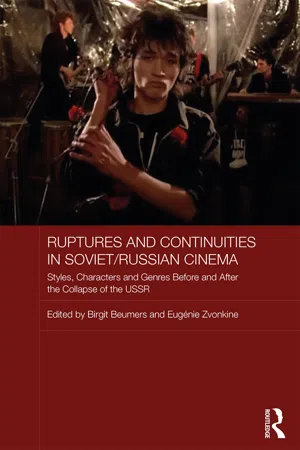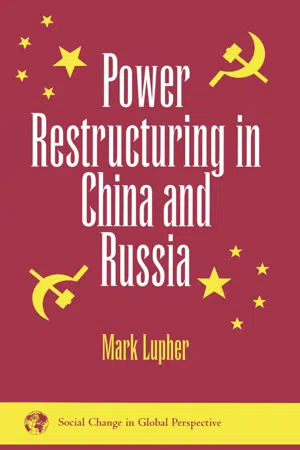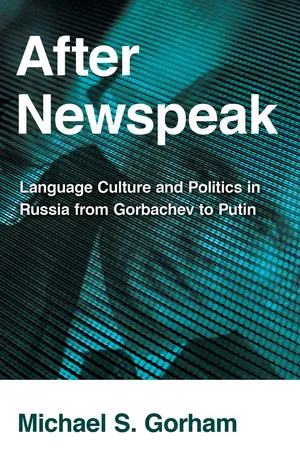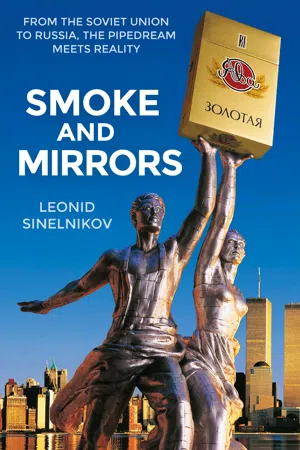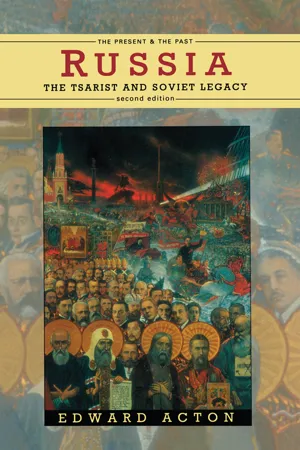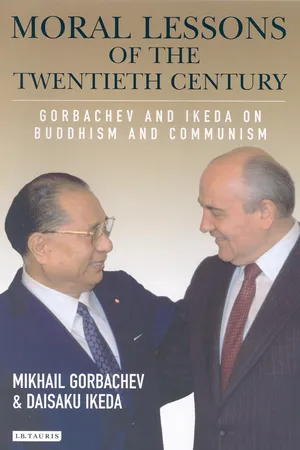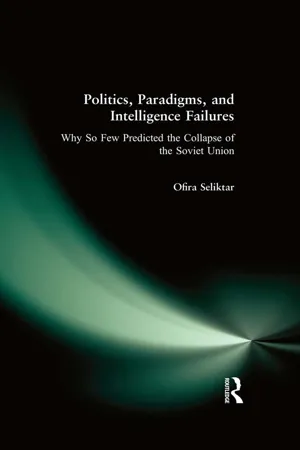History
Glasnost and Perestroika
Glasnost and Perestroika were policies introduced by Soviet leader Mikhail Gorbachev in the 1980s to reform the political and economic systems of the Soviet Union. Glasnost, meaning "openness," aimed to increase transparency and freedom of expression, while Perestroika, meaning "restructuring," sought to modernize and decentralize the economy. These reforms ultimately contributed to the eventual dissolution of the Soviet Union.
Written by Perlego with AI-assistance
Related key terms
Related key terms
1 of 4
Related key terms
1 of 3
10 Key excerpts on "Glasnost and Perestroika"
- eBook - ePub
- Olessia Koltsova(Author)
- 2006(Publication Date)
- Routledge(Publisher)
perestroika period when struggle with an external enemy (in the person of the power elite) became an integral part of professional identity for many journalists. This heroic image was to flourish in the coming years of transformation.Transformation
Perestroika: decay of the old system
The Russian word perestroika means rebuilding and reorganization; usually the boundaries of this period are considered to coincide with the years of Mikhail Gorbachev’s rule (1985–91). Gorbachev belonged to that faction of the political elite who believed that the Soviet system, being obviously less effective than its Western competitors, needed some amendments. An important part of the perestroika policy was the doctrine of glasnost. Glasnost, meaning openness and publicness, is derived from the word glas (voice), and thus also implies voicing something that had previously been silenced. When declared officially, glasnost immediately intensified journalistic practices of resistance against the “external enemy,” and very quickly the situation went out of control.At first secondary ideological bans were lifted. Because of the obvious discrepancy between media-constructed images and everyday life glasnost first appeared in mass media as verbalizing things that everybody knew but could not say publicly (Konstantinov 1998). Even in the early stages of glasnost not all such statements were approved by the authorities. Activities in defiance of bans extended, and different methods were used.On TV the first and most essential of such methods was live broadcasting. In 1986 a youth program “12 etazh” (The 12th storey) allowed indignant statements of high-school students addressed to educational officials to be broadcast. Later Eduard Sagalaev, the host of the program, was very surprised that none of the officials responsible for TV phoned him after the broadcast. As he assumed afterwards, each official was sure that the program had been approved by another (Mickiewicz 1997: 68). Throughout the country, journalists regarded such cases as precedents, and started making them a common practice. To restore a particular ideological taboo after that became more and more difficult. The years 1987–8 saw the press flooded with revelatory publications about Stalin’s regime. In 1989 media raised one of the last topics which had remained untouched: Lenin. The first unorthodox mentioning of the leader, though it might seem quite innocent to an outsider, produced a scandal: a Russian celebrity publicly proposed to bury Lenin’s remains. This statement would have never appeared on air, but TV journalists tricked the censors using Russia’s division into different time zones. Usually party officials previewed program versions broadcast to the Far East, after which densely populated European Russia, including Moscow and Leningrad, received censored programs. This time the censors themselves were shown an abridged version that did not contain any discussions about Lenin. Nobody dared take the program off the air when the full version was broadcast to Moscow. - eBook - ePub
Ruptures and Continuities in Soviet/Russian Cinema
Styles, characters and genres before and after the collapse of the USSR
- Birgit Beumers, Eugenie Zvonkine, Birgit Beumers, Eugenie Zvonkine(Authors)
- 2017(Publication Date)
- Routledge(Publisher)
Introduction: Re-construction, or perestroika Re-visioning, re-making, re-framing Birgit Beumers and Eugénie ZvonkineFor many years, scholars have talked about things Soviet and post-Soviet. The collapse of the USSR in 1991 clearly deserves to be considered as a watershed between eras, political and historical, but also cultural. However, over 30 years have passed since the arrival of Mikhail Gorbachev at the post of General Secretary of the Communist Party of the Soviet Union (CPSU), since 1990 President of the USSR, and the announcements of reforms, above all perestroika (reconstruction), assisted by the policy of glasnost (openness) to facilitate a re-assessment of history and society – both relevant to cultural production. Over a quarter of a century has gone by since the collapse of the Soviet Union, and a whole generation has been born since, as Russian – not Soviet – citizens. So it may seem that the time is ripe to abandon the term ‘post-Soviet’ and re-assess that period of perestroika: was it really a period of a watershed? Did it really rupture cultural history, or are there also continuities when we look beyond (before and after) the exciting years from 1985 to 1991, those last years of the Soviet Union? This volume sets out to re-assess the perestroika era and its key symbols from the perspective and context of 30 years later.The 1980s are probably the most non-homogeneous decade in Soviet history: a time that goes from Stagnation through perestroika and glasnost to the collapse of the Soviet Union. It is also the decade with the greatest number of leaders: Leonid Brezhnev, who died in 1982, was followed in short succession by Iurii Andropov and Konstantin Chernenko, until finally Mikhail Gorbachev was elected General Secretary on 11 March 1985. Between that date and his resignation on 24 August 1991, he attempted to effectuate the country’s transition from a communist bureaucracy into a more democratic form of socialism, relying heavily on the support of the media and the intelligentsia. On the whole, Gorbachev had the backing of a part of the Politburo that he had rejuvenated, facing resistance from hardliners (for too many reforms) and the more liberal intelligentsia (for insufficient reforms) among the People’s Deputies. However, the Gorbachev era was no doubt one of the most exciting periods in Soviet history, bringing to the forefront artistic works that had previously been banned, forbidden, pushed into the underground or else marginalised. This made the Gorbachev era, and especially its culture, particularly attractive to the West – the media and cultural organisations devoted entire programmes to Soviet art and culture. The ground for this had no doubt been laid by the memorable 12-part BBC documentary Comrades - eBook - ePub
Five Years That Shook The World
Gorabchev's Unfinished Revolution
- Harley D. Balzer(Author)
- 2019(Publication Date)
- Routledge(Publisher)
Pravda, May 17, 1985.9. Gorbachev speeches at CC Plenum January 27 and 28, 1987. Economic reforms were adopted at the CC Plenum in June, to take effect January 1, 1988.10. This is clearly seen in the military response to Ministry of Foreign Affairs, Sovetskaia Rossiia, January 9, 1991, p. 5.11. See the "Summary of Leadership Changes" at the back of the volume.12. Joseph Rolthschild, Return to Diversity: A Political History of East Central Europpe Since World War II (New York: Oxford University Press, 1989); Karen Dawisha, Eastern Europe, Gorbachev and Reform (New York: Cambridge University Press, 2nd edition, 1990); and Charles Gati, The Bloc That Failed: Soviet-East European Relations in Transition (Bloomington: Indiana University Press, 1990).13. Glasnost has been variously translated as "openness," "frankness," and "publicity." I prefer "frankness," but whatever the translation, the key element of the concept is a component of shared culture-the leadership assumes the population will use the opportunities to behave in a responsible manner, and will not violate cultural norms. Gorbachev's disucssion in Perestroika -a book for Western consumption-is instructive: "Let the Party know everything." "...these bills are designed to ensure the greatest possible openness." "Criticism is, first and foremost, responsbility, and the sharper the criticism, the more responsible it should be." "To uphold the fundamental values of socialism is a tradition of our press." (pp. 61-66, my emphasis). Nikolai Chernyshevskii's comment that glasnost was a word devised in place of freedom of speech appears relevant here.14. Ellen Mickiewicz, Split Signals: Television and Politics in the Soviet Union (New York: Oxford University Press, 1988) pp. 60-68.15. For a good summary of the contradictions see the article by A. Illesh and V. Rudnev, Izvestiia, - eBook - ePub
- Mark Lupher(Author)
- 2018(Publication Date)
- Routledge(Publisher)
Especially striking was the argument that perestroika was the logical manifestation of the changes and maturation that Soviet society had experienced in the two or three preceding decades. In 1988, Moshe Lewin argued that urbanization, scientific-technical development, and massive increases in the number of people with higher and specialized secondary education had transformed “the nation’s overall social, professional, and cultural profile.” In contrast to the backward, rural country that had produced Stalinism, Gorbachev’s rise marked “the coalescence of a civil society capable of extracurricular action and opinion making, independent of the wishes of the state.” Thus, “authoritarian coercion, once a favored tool, would no longer be of much use. Instead, internal politics is learning to use a new language: interplay and bargaining, yielding and conforming, pressuring and compromising, giving and taking.” 6 Similarly, Blair Ruble asserted that, contrary to prevailing views in the West and the Soviet Union, “the Brezhnev period was not one of stagnation but of profound social transformation,” when “the Soviet population increasingly came to resemble the industrialized world in terms of education attainment, employment patterns, cultural taste and, to a surprising degree, attitudes.” As a result, “the combination of striking new policy initiatives from above and dramatic social change from below has created an environment in which the Soviet Union just might finally be able to step off the treadmill of failed reforms.” 7 Finally, Jerry F. Hough managed to combine elements of both the preceding perspectives in an idiosyncratic analysis of Gorbachev and perestroika. On the one hand, Hough stressed the familiar ways in which Gorbachev used the “General Secretary’s machine” to steadily consolidate his power and build his personal authority in the 1980s - eBook - ePub
After Newspeak
Language Culture and Politics in Russia from Gorbachev to Putin
- Michael S. Gorham(Author)
- 2014(Publication Date)
- Cornell University Press(Publisher)
According to the Oxford English Dictionary, it is the most recent nonscientific Russian word to date, together with perestroika, to have earned citizenship in the English language. 1 This, ironically, makes translation more difficult. English-language dictionaries attest to this by avoiding all one-word synonyms, as in the American Heritage Dictionary, where it is defined as “an official policy of the former Soviet government emphasizing candor with regard to discussion of social problems and shortcomings.” 2 The OED comes closest to capturing the evolutionary nuances of the term as policy: “In relation to the affairs of the Soviet Union: a declared party policy since 1985 of greater openness and frankness in public statements, including the publication of news reflecting adversely on the government and political system; greater freedom of speech and information arising from this policy.” Literally, glasnost, which comes from the adjective glasnyi (public), means something approximating “publicity” in English and dates back in the Russian political lexicon at least to the early nineteenth century. Derived from the root GLAS/GOLOS (“voice,” “vote”), the term’s etymology underscores the tight link between speech and politics. But as with most political concepts, the literal meaning only scratches the surface. Even the best word etymology will fail to do justice to the complexity of glasnost, in part because of the rich history of the concept and in part because of the additional layers of meanings and nuances it acquired as it passed through the ideological and pragmatic filters of the Gorbachev era, especially once the word became policy. As it turns out, it meant a variety of things to a variety of key political players, and it is precisely the protean nature of the term, the ambiguous semantic and pragmatic values it carried during the critical years of the Gorbachev reforms, that made it so powerful - eBook - ePub
Smoke and Mirrors
From the Soviet Union to Russia, the Pipedream Meets Reality
- Leonid Sinelnikov(Author)
- 2021(Publication Date)
- Unicorn(Publisher)
216CHAPTER 13.GORBACHEV’S PERESTROIKA – THE LONG-AWAITED ERA OF CHANGE
M ikhail Sergeyevich Gorbachev was not an especially popular figure in the country at the time, but the appearance of a comparatively young man, a new face, presented at least some hope of change. No one, however, suspected that this appointment would end up turning the life of our vast nation upside down. This new era, which became known throughout the world as perestroika, may without exaggeration be called the brightest period in the history of the USSR. The man who instigated and inspired the sweeping changes was Gorbachev himself, who very accurately identified the primary targets of long-overdue reform. The policies of perestroika (restructuring) and glasnost (openness) were designed to put paid to the worst vices of the Brezhnev era: stagnation and the concealment from the people of the real state of the affairs in the country. The people enthusiastically supported the need for serious changes. If the country was to have any chance of overcoming its profound social and economic crisis, the Party-based, bureaucratic style of administration that had formed in the Brezhnev period would have to be cast aside. Gorbachev began from the very top of the Party. Literally before people’s eyes, the Politburo was radically overhauled. One by one, members of the old guard began to shuffle into retirement. With Gorbachev’s arrival, the old rule book was thrown out. The General Secretary’s wife, Raisa Maximovna, began to appear at his side at official events. Unlike the wives of the previous leaders, she looked really quite modern. People began to talk of the USSR having a “first lady” just like in other countries throughout the world.The extent to which bureaucratism had penetrated Party-state structures was revealed in the first few months of the perestroika policy. The first victim was the anti-drinking campaign announced by the new leadership. As I have already mentioned, the problem of drunkenness had taken a sharp turn for the worse during the Brezhnev years, and by now had turned into a national calamity. Per capita alcohol consumption had exceeded all previously set records. People 217 - eBook - ePub
Russia
The Tsarist and Soviet Legacy
- Edward Acton(Author)
- 2014(Publication Date)
- Routledge(Publisher)
This, too, could be solved by adapting rather than abandoning the ‘socialist’ commitment to social ownership, central planning and full employment. In the international sphere, unlike his predecessors, he had concluded from his Western contacts that Soviet security and international standing would be enhanced rather than imperilled by a drastic reduction in nuclear arms. Certainly Gorbachev was conscious that he and his allies were embarking upon a drastic break with precedent: ‘If not us, then who? If not now, when?’ was the evocative phrase he used in the summer of 1986. 1 But he was convinced that the stability of the Soviet Union and the maintenance of Communist Party rule were compatible with far-reaching reform. What buoyed up this confidence was the overwhelmingly positive response to his early reforms. It could hardly be otherwise. Gorbachev’s slogans – economic uskorenie (acceleration) and perestroika (restructuring), greater glasnost (openness) in public life, and demokratizatsiia (democratization) – were so elastic and the ultimate destination so unclear that all could at least pay lip-service to them. The dictates of party discipline inhibited those officials most committed to the status quo from overtly challenging their own leader, while many middle-ranking officials positively endorsed his analysis and eagerly seized upon the opportunities for promotion opened up by his drive against ‘dead wood’. A broad spectrum of white-collar workers both within and outside the Party welcomed the new scope he promised for professional autonomy and initiative; some, including teachers and medical workers, benefited from an early and sharp wage rise. The creative intelligentsia were delighted by increased intellectual and artistic freedom. Among workers, scepticism was greater from the outset, not least over Gorbachev’s emphasis on intensifying labour and stretching differentials. But they, too, could hardly oppose the proclaimed goals of the new leadership - eBook - ePub
Russia in the Twentieth Century
The quest for stability
- David R. Marples(Author)
- 2014(Publication Date)
- Routledge(Publisher)
In late December, when the Congress granted Gorbachev enhanced powers, the President nominated Gennady Yanayev as his Vice-President – a strange choice. Only at the second attempt, and after prolonged persuasion from Gorbachev, could Congress be persuaded to accept it. Yanayev was a dull apparatchik with no interest in reforming the Soviet system. Other appointments made by Gorbachev in the same period did not augur well for the future of a reform program and democracy – Boris Pugo as the chief of police, and Kryuchkov as the head of the KGB – while the loss of Shevardnadze and especially of Aleksandr Yakovlev suggested that the President had made a significant about-face. By early 1991, Gorbachev had begun to demand restrictions on freedom of the press. Mass demonstrations in Moscow were banned. The experiment in political change appeared to be over. Gorbachev’s challenge, clearly, was the growing power of the republics, and of Russia in particular. (Plate 8.2) The perils of Perestroika By most calculations, the introduction of Glasnost into Soviet society has to be considered a success, even though the open criticisms of the Gorbachev administration served to lower its credibility and Gorbachev appeared to resent personal attacks on his leadership. Perestroika proved much more difficult. Soviet reports on the economy had never been frank, particularly the reporting of harvests and other economic statistics. The state continued to fix prices for goods and to subsidize struggling firms. There is no doubt that the economy was a key priority for the Soviet leader, but what was the goal of Gorbachev’s proposed economic reforms? Was it even possible to reform the archaic system? If so, how far could Gorbachev go? That there should be some decentralization, concessions to local decision-making, redistribution of profits and the like seems self-evident - eBook - ePub
Moral Lessons of the Twentieth Century
Gorbachev and Ikeda on Buddhism and Communism
- Mikhail Gorbachev, Daisaku Ikeda(Authors)
- 2005(Publication Date)
- I.B. Tauris(Publisher)
CHAPTER TWOPerestroika and Freedom
Ikeda: In 1990, you told me that the main significance of Perestroika is the freedom it brought. In thinking about how freedom is put to use, you cited an example that recalls a Platonic allegory. The rays of the sun blind a person who suddenly emerges into the light after long confinement in a dark prison or a deep well. Similarly, people who have suddenly received freedom use their newly acquired independence solely to dwell on the past instead of examining the present and thinking about the future.You, of course, sincerely believe in Perestroika, as is shown in a letter written to me by Chingiz Aitmatov. I received this letter, which bears the title “A Parable Related to Gorbachev”, soon after you retired from the presidency.In the Kremlin.That meeting stands out in my mind more than all others. I assume that Gorbachev summoned me with a concrete aim, most probably, as I now think, to discuss the pressing situation in Middle Asia, particularly the national crisis. But, perhaps because of my own unintentional fault, instead of concerning substantial business, our conversation took an entirely different turn. This is why.To understand the heart of what happened, the reader must realize that Perestroika as a process of unprecedented democratic reforms was in full swing. But a subterranean rumble of dissatisfaction and ever-rising criticism was distinctly gathering momentum from the right and the left—from the democrats and the bureaucrats. Everyone had his own arguments and reasons. The national economy was steadily sinking.Certainly Gorbachev’s mind was uneasy at that hour. Although the imprint of inner anxiety lay on his face, he controlled himself as usual. When he smiled cordially, his eyes occasionally flashed with the characteristic Gorbachev sparkle.We were seated across from each other at a desk in one of his Kremlin offices. In a natural fashion, before getting down to the main topic, Gorbachev demonstrated interest in my literary affairs—what was new, what was I working on, could he expect a novel or a short story? Soon? Without realizing it, he touched on a very tender topic. In those days, I had practically no time for literary worry. I decided to tell him all about it. - eBook - ePub
Politics, Paradigms, and Intelligence Failures
Why So Few Predicted the Collapse of the Soviet Union
- Ofira Seliktar(Author)
- 2015(Publication Date)
- Routledge(Publisher)
By casting its lot with Gorbachev, the administration hoped to demonstrate its confidence in perestroika and prevent a violent disintegration of a nuclear-armed Soviet Union. The unforeseen consequences of such a development alarmed even the most seasoned practitioners on Bush’s team. As Gates (1996, 484) put it, “we shot the rapids of history, and without a life jacket.” Still, the decision was taken despite the fact that internal deliberations leading up to Malta revealed less than robust confidence in Gorbachev’s long-term survivability. But even the “Gorbachev’s pessimists” were surprised by the speed of events that would lead to the collapse of the communist empire almost two years to the date after the summit. Gates (1996,461) captured this feeling well. He wrote that in “boarding the roller coaster” in 1989, “experts all, we had no idea what lay in store for us sooner than we could imagine.” The extraordinary events that culminated in 1989 had also tested the academic paradigms, already working overtime to discern the future.Paradigmatic Reconfigurations: Changing the View of the Past as a Way to Predict the Future
Unlike the intelligence services, which dealt with immediate events, the academic community used Moscow’s disclosures about the true state of its economy and society to reexamine the underlying precepts of Soviet analysis. With its emphasis on the high performance of the Soviet system, the revisionist paradigm stood to lose the most from Gorbachev’s admission of its many failings. One historian was elated that glasnost provided a “fascinating opportunity” to study “all sorts of pathologies formerly denied” (Powell 1988, 302). A special issue of Survey entitled “Seventy Years After the Revolution” (1987) listed the numerous ways in which the system had malfunctioned. These were also detailed by Abel Aganbegyan (1988b, 1988c) and by Nick Eberstadt (1988, 10) in his study of poverty in the Soviet Union. Eberstadt’s conclusion that communist rule was short on bread as well as freedom challenged the notion of patrimonial legitimacy that was at the core of the revisionist approach. Indeed, even such admirers as John Kenneth Galbraith were now compelled to admit that the Soviet economy had fizzled out in the mid-1970s (Galbraith and Menshikov 1988, 19).As perestroika revelations mounted, other assumptions of the revisionist paradigm crumpled. The role of a single party as an “effective agent of development” was questioned, and there was an increased acknowledgment of the role of coercion as the major instrument in maintaining regime stability. A 1987 conference organized by Ferenc Feher, a former neo-Marxist associated with the patrimonial model, had actually admitted as much (Gill 1987, 566; Feher and Arato 1989). Using the newly available data on the Gulag system, Laqueur (1989, 241) criticized revisionist historians like J. Arch Getty and Sheila Fitzpatrick for underestimating Soviet terror. The ever outspoken Aleksandr Solzhenitsyn (1988) condemned Western Sovietologists for ignoring the oppressive quality of the regime and for failing to admit that communism could not survive without state terror.
Index pages curate the most relevant extracts from our library of academic textbooks. They’ve been created using an in-house natural language model (NLM), each adding context and meaning to key research topics.
Explore more topic indexes
Explore more topic indexes
1 of 6
Explore more topic indexes
1 of 4
